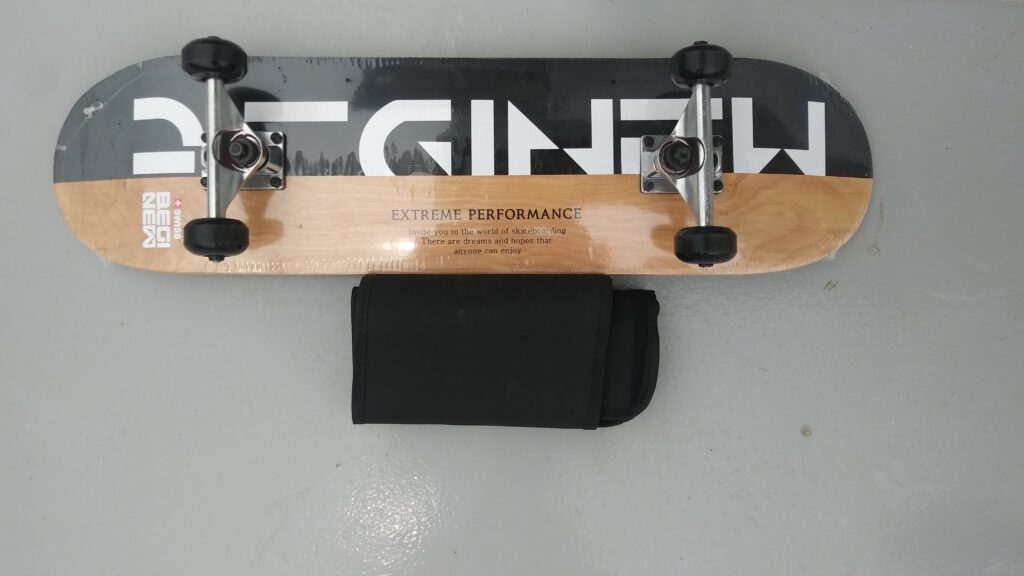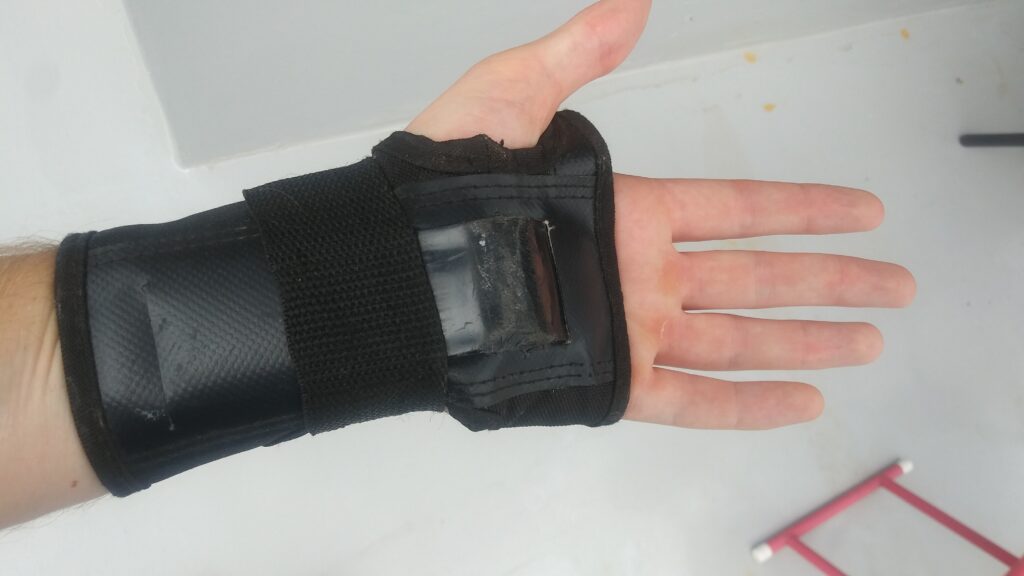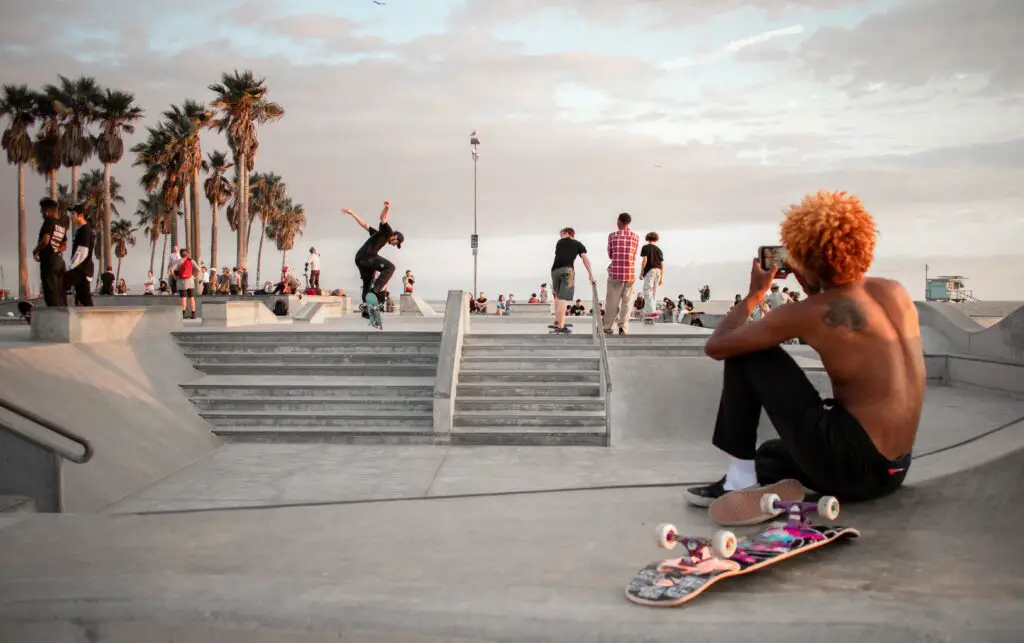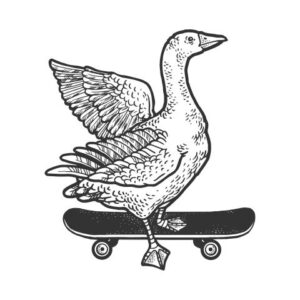Skateboarding as an adult can be one of the best decisions of your life. You will get outside, get a workout, meet friends, and have a creative outlet through skateboarding.
Skateboarding as an adult is easy to get started. You will need to first buy essential gear. This includes a complete skateboard, a helmet, skate shoes, and wrist guards. The total cost of these items is around $200. After this, you simply need to get outside practicing.
There’s obviously a bit more to skateboarding as an adult than that, but on a high level, this is true. The biggest thing I want you to understand is the two realities of skateboarding as an adult.
The Reality of Skateboarding as an Adult
So you want to skateboard as an adult? Congrats on the decision, but there are some things you need to be aware of.
There are two big realities when skateboarding as an adult. One is that you will likely never be as good as the people on YouTube who are doing varials over stairs. You won’t have the time to reach that level of skill. The second reality is that you will get injured at some point skateboarding if you are trying tricks. Skaters who do tricks get hurt and some injuries have long-lasting effects.
Let’s go over these two factors in some more depth.
Achievable Skill
The most talented skaters started early. They were skating as children or early teenagers. They had the time to completely commit to skateboarding for years while their bodies were still flexible and recovered quickly.
This is almost always the case when it comes to professional and very skilled skaters. If you start later in life, it is extremely unlikely you’ll reach an advanced level of skill in skateboarding. This comes down to two main reasons.
First of all, your body cannot take the stress of skateboarding every day and when you become injured you don’t recover as quickly. Second of all, you likely have a job and busy schedule and cannot spend 20+ hours a week skateboarding. This is the amount of practice that skateboarding professionals do each week.
So you need to understand your limitations. Many people get frustrated with their lack of progress in skateboarding. Even an ollie is a complex trick that will take months of dedication to master. Many people think of it as the first beginner trick and don’t realize how difficult performing a good ollie is.
This doesn’t need to be a problem though.
If you are happy with small progress and don’t get an ego about it, you can still have a wonderful and fulfilling time skateboarding. All of the basic tricks are within reach and you will still find plenty of little victories to celebrate. Just be patient and enjoy the sometimes lengthy process.

Safety
As an adult, safety should be your number one concern. You’re bigger so you will fall harder. You’re less flexible so you will sprain joints or tear muscles easier. You have to work to live so you can’t miss work because of a skateboarding injury.
Skateboarding is inherently a bit risky. You’re riding a piece of wood with wheels over concrete. Things can go bad.
The reality is you will get injured from skateboarding at some point. I don’t know a single skater who has never been injured. The other reality is that some injuries never heal completely. For example, spraining your joints elongates your tendons in the joint. Often without surgery, these tendons never return to the same length and are weaker and more likely to become injured again.
Ankle sprains are incredibly common in skateboarding. I have sprained both of my ankles many times. My left ankle permanently clicks when I walk because it has been elongated. I feel no pain and still have good movement with my ankle, but it will never be what it once was and is easier to reinjure.
I don’t want to scare you away from skateboarding, but you need to know the risk involved. However, as you progress and become better at skateboarding, you will rarely get injured. The riskiest period is when you are first beginning or are trying new tricks. That’s why it’s important to practice good safety and not push too hard.
If you are older than 21 or 22, this applies to you. Injuries you get now can become permanent fixtures in your later life. So be careful, but also have fun.
If your knees hurt from skateboarding check out our guide on why this happens and how to prevent it
Equipment Required
If you want to get started skateboarding, there is some essential equipment you will need. This includes a complete skateboard, skate shoes, a helmet, and wrist guards. There is some other gear that would be nice to have but is non-essential. The total cost for all of this is around $200.
Overall, that’s pretty cheap compared to other sports such as snowboarding or surfing.
Skateboard
So surprise surprise. You will need a skateboard if you want to skateboard.
Without going into too much detail here, I recommend buying a complete skateboard. Completes are cheaper than building your own skateboard which is best for a beginner. You don’t want to buy the most expensive gear for a hobby you might quit in a month.
The only size you will want to be aware of is the width of the board. 8 inches is the standard width and you can go up to 8.25 inches for a more stable ride. I wouldn’t recommend more than 8.25 inches in width or the board will get bulky. I also wouldn’t recommend narrower than 8 inches for a beginner.
Don’t think too much about the width, because it doesn’t make a big difference. Be willing to pay for a decent board and then just focus on picking out a pretty graphic.
I go over the price for a decent skateboard here, but the gist is that you’ll likely pay $80-$100 on Amazon or a company site. This price is for the traditional street-style skateboard, not a cruiser style. Cruiser boards can go for around $40-$90, but you will not be able to do many tricks with them.

Skate Shoes
Proper shoes are an essential item if you plan on doing any sort of tricks. If you just want to cruise, almost any shoe with a flat sole is ok. If this is your case then you can skip this section.
Otherwise, you will need a skate shoe. Sneakers are not ok. Thin-walled Vans are not ok. You need a shoe with flat soles that have thicker padding on the sides. If you don’t have flat soles, it will be hard to balance and stop your board. If you don’t have thick sides, then your ankle will scrap the board when you ollie.
You will also want a pair of shoes specifically for skating because these shoes will get torn up pretty quickly. They will no longer be presentable after only a few skate sessions.
Nowadays, Vans, Nike, Adidas, and other big brands all make skate shoes. I won’t go into detail about the best brands here, because it doesn’t really matter for a beginner. Any shoe will be fine for just getting started.
Just remember flat soles and thick, padded sides. You’ll likely pay between $40-$100 for a decent pair of skate shoes.
Helmet
The helmet is a piece of protective gear that too many skaters completely forgo. It’s bulky, uncomfortable, and just isn’t cool.
Honestly, when I got back into skating as an adult, I never wore a helmet. I still don’t today. Though I did have some earlier experience skating and have good board balance.
If you are skating bowls and half pipes, then helmets are essential. You can fall backward from the top of a halfpipe and kill yourself with a head injury. This is commonsense and even legendary older skaters like Tony Hawk and Tony Alva wear helmets when skating transition. Transition means bowls, half pipes, and ramps if you don’t know the terminology.
If you are skating flatground, street style, or just cruising then helmets are less necessary. If you are experienced. This is the important point. Beginners are going to fall often. Your risk of a head injury is much higher when you’re first starting out.
So for absolute beginners, I recommend a helmet no matter what type of skate style you want to learn. It’s the smart thing to do and could save your life.
You’ll likely pay $20-$30 for a standard skateboard helmet.
Wrist Guards
Wrist guards really are a must as a beginner or for any adult skater. You will be falling often if you are attempting tricks and you will want to use your hands when you fall. You shouldn’t, but this is a natural reaction.
I sprained my wrists too many times before I learned my lesson. I don’t want you to do the same. These are essential and will be used much more than your helmet. Although your helmet might just save your life.
You’ll likely pay $10-$25 for your wrist guards.

Extra Equipment
Elbow and Knee Pads
Honestly, if you are a complete beginner you might also want elbow and knee pads. If you are trying to skate bowls, half pipes, and ramps, then everyone should use them.
If you are trying to skate street style and small inclines, then they honestly aren’t so necessary. It is very rare to fall on your knees once you have learned how to properly fall. The same goes for elbows. I’ve only fallen on my elbows when dropping into mini ramps. It simply rarely, if ever, happens skating flatground and street.
So using elbow pads and knee pads is up to you. Just be honest with yourself about your flexibility, weight, and level of balance. If you are heavier, not flexible, and have little to no board balance, then elbow and knee pads are a good choice.
I wouldn’t go fancy and buy anything expensive if you do. You can definitely bundle all of your pads with a helmet on Amazon. You can expect to pay around $25-$50 for your elbow and knee pads packaged together.
Insoles
Insoles are nice to have, but definitely not necessary. I am mainly recommending them here because they can save your knees and feet from a lot of stress and pain. This becomes more of a concern as we get older.
This mainly applies to skating street style and doing tricks. If you are skating transition, then you really don’t need them as you won’t be having many repetitive impacts as you skate.
The best and most widely regarded skate insole brand is from Footprint. This brand is made using technology that is currently used in the space station so that’s super cool. The cost ranges from $30-$55 for a pair.
Check them out here.
Total Cost to Get Started Skateboarding
Skateboarding does require a bit of up-front investment.
Taking into account everything you need to buy to get started skateboarding, the total cost is about $200. This includes a complete skateboard, skate shoes, a helmet, and wrist guards. If you also want elbow pads, knee pads, and insoles, the total cost goes up to around $250-$280.
These may seem like a lot, but keep in mind this is all a one-time expense. The biggest cost beyond this initial investment might be classes or a private skatepark membership. There are plenty of ways to learn and skate for free, however.
There’s no reason skateboarding should be expensive.
If you want to know how much a skateboard should cost check out our guide to skateboard cost for completes and custom setups.
Where to Skate
Starting off you will want to be skating flatground. You don’t want to overcomplicate things as you get comfortable with your board. Many beginners are tempted to start in a small concrete patch in their backyard or garage. This really isn’t ideal because you’ll never have the space to ride and get comfortable on your board.
Luckily skateboarding can be done in many places whether you have a skatepark near you or not.
Skatepark
I’m putting the skatepark first because it is the obvious best choice. If there is a skatepark near you, then hop in your car and go.
The benefits of a skatepark include smooth pavement meant for skating, usually no bystanders to stare, and the potential to meet and get tips from other skaters.
As a beginner, you will want to steer clear of any bowls, halfpipes, stairs, or even inclines at first. You want to start on flatground and get a feel for riding your board. Don’t be nervous about what other people think of you as a beginner. Most people don’t care.
You will feel a little conscious as an adult starting off, but just go for it. You have to suck to get better. Before other skaters see you skate, they will likely think you’ve been doing it for years simply because of your age. Again, don’t worry and have fun.
If you truly are very self-conscious then it’s ok to practice flatground at a more secluded spot first to get some basics down. Keep in mind you will end up feeling self-conscious as a skatepark beginner at some point so there isn’t too much a reason to postpone that.

Your Neighborhood Street
This is an easy place to first get rolling. It depends on how much traffic your residential street gets or not, but nothing beats the proximity and accessibility of your own street. There should also be enough space to start actually riding and turning.
Just be careful of parked cars as your board might fly off when you fall. Also, your neighbors will likely see you skate as a total beginner adult. Some people will be self-conscious of this. No worries, you’re only human.
Using these factors, you can make the decision if your neighborhood street is right for you.
Parking Lots
Parking lots are great for beginners.
They are flatground, usually have smoothish pavement, and are often empty of witnesses so there’s no pressure to look cool as you first get started.
They are also simply everywhere. You can hop in a car and find a parking lot that you’ll be able to skate somewhere in your city/town guaranteed.
The only downsides here are that you might get kicked out for skating there. This can happen, but don’t worry. You’ll just be asked to leave which you will. Don’t argue or complain. You’re an adult and can get arrested.
Parking Garages
Parking garages are almost identical to parking lots, but there is cover from the rain and often you can carve down to different levels.
I find that I’m more likely to get kicked out of a parking garage than a parking lot. Also, pop tricks tend to echo inside and make a lot of noise. Parking garages might be your only respite when it rains so you might end up seeking one out anyway.

Parks
Parks are also great spots to skate around. There are no cars, usually smooth pavement, and lots of natural obstacles to learn to turn around. Usually, you’ll find a lot of bystanders, but most people won’t pay any attention to you. There also likely won’t be other skaters at a normal park if that’s something that makes you anxious.
There is also a small chance you’ll get asked to leave when skating a pedestrian park. Unfortunately, this happens.
What to Learn First
There are some basics you need to know to get started. This happens before you learn your first trick. These skills are necessary to simply ride around on your board.
1. How to Stand on Your Skateboard
Standing on your skateboard can be a matter of choice, but there is a popular choice. I recommend the popular choice where your front foot (your non-dominant foot) is placed so your toes are above the front axle. Your back, the dominant foot will push off and come onto the board above the back axle or slightly more forward.
Your front foot will be positioned to face forward or at a 45-degree angle while you push but will transition to being perpendicular to the board direction once both feet are on the board and you’re really moving.
2. How to Push Off
This is how you start moving with your skateboard. You want to move don’t you?
With your front non-dominant foot placed above the front axle, you will use your dominant foot to push off of the concrete. This will propel you forward.
This can be tricky because if you lean too far to the right or left then you will begin to turn. Your foot needs to be centered on the board.
Practice practice practice. Push off and push off until it is second nature to you and you can reliably go straight forward.
3. How to Stop
The easiest way to stop on a longboard is by dragging your dominant foot flat on the ground. This is actually quite tricky and there is another way to stop on a skateboard where you simply put the tail of the board on the ground.
To drag your foot you need to have just enough contact to slow down, but not catch your foot and stop abruptly and suddenly. This results in a balancing act as you hang your foot just right off the board so it drags the pavement. You can’t just slam your foot down to stop because at high speeds stopping abruptly can cause injuries.
The most common mistake is the desire to catch yourself with your hands and arms. This is an easy way to get a wrist sprain and potentially break your wrist.
If you are falling down an obstacle or with any forward momentum, then you will want to tuck and roll. This will spread the impact force through your shoulders and back. You can use your hands to help pivot into the tuck and roll, but absolutely do not use them to catch yourself. This will end badly.
If you are falling backward, then you will fall on your butt. Do not try to catch yourself with your arms or hands. Your hands might end up under you as you hit the ground. This will end badly.
Practicing this is easiest to do on a bed or something softer. This is because it is easier to bruise your butt when falling this way.
After learning how to stand, push, stop, turn, and fall properly then you’re ready to go out and cruise your city or start learning more advanced tricks. If you want to learn tricks, understand that this process will be hard on your body as an adult and you will fall and likely injure yourself at some point.
Still, don’t be deterred, because you can still skate relatively safely with precautions and life is too short to not have some fun. So enjoy!~ Now the real fun starts.
What to Learn Next
Once you can stand on your board, push off, stop, and turn then you need to give yourself some time to practice these and get comfortable on your board.
How you progress after that is up to you. If you want to do tricks, then I would begin to try and learn to ollie as this is the foundation of almost all street tricks.
If you want to carve or skate transition, then first learn to kick turn. This can be done on flatground or on a mini ramp.
You can find tutorials all over YouTube and Board and Wheels will be creating some basic tutorials as well soon.
Expected Progression
The following table is the expected progression of an adult who has never skateboarded before and is committing to three days a week of skating. This is for skaters who want to learn tricks. I also assume you spend about 1.5-2 hours per skate session.
For an adult with a busy schedule, this is pretty aggressive. Still, learning to skateboard takes a lot of time. Stick it out though, because skating gets more fun as your ability improves.
| Month | Working On | Mastered |
| 1 | -Standing on your board, pushing off, stopping and turning | |
| 2 | -Standing on your board, pushing off, stopping and turning -Kickturns -Ollie | |
| 3 | -Getting comfortable on your skateboard -Kickturns -Ollie | -Standing on your board, pushing off, stopping and turning -Can do kickturns, but not mastered |
| 4 | -Getting comfortable on your skateboard -Kickturns -Ollie | -Standing on your board, pushing off, stopping and turning -Can do kickturns, but not mastered -Can ollie, but not mastered |
| 5 | -Ollie -Backside 180 -Pop-shuvit -Dropping in | -Standing on your board, pushing off, stopping and turning -Comfortable on your board -Kickturns -Can ollie, but not mastered |
| 6 | -Ollie -Backside 180 -Pop-shuvit -Dropping in | -Standing on your board, pushing off, stopping and turning -Comfortable on your board -Kickturns -Can ollie, but not mastered -Can backside 180, but not mastered |
Conclusion
So in conclusion, skateboarding as an adult can be fun and challenging. You need to be aware of the safety aspects a bit more and listen to your body. Don’t push yourself too hard.
The startup costs including a skateboard, shoes, wrist guards, and a helmet will likely be around $200. Though this is really a one-time upfront cost and then you’re good to go. If you start doing tricks, you will go through shoes every few months.
The reality of skateboarding as an adult is that you can get injured easily, you will look and feel ridiculous at some points, and you’ll likely never be as good as the skaters you see on YouTube doing varial flips over stairs. That being said, you can have a ton of fun skating as an adult and make a lot of friends as well.
Personally, I think the decision to begin skating as an adult is an amazing one. Beyond exercise and getting outside, you are really challenging the limits of your body and doing something that is against the status quo. You will hopefully gain some of the sense of freedom and expression that many people have found through skateboarding.
So that’s it. Thanks for reading and look out for more content from Board and Wheels.



